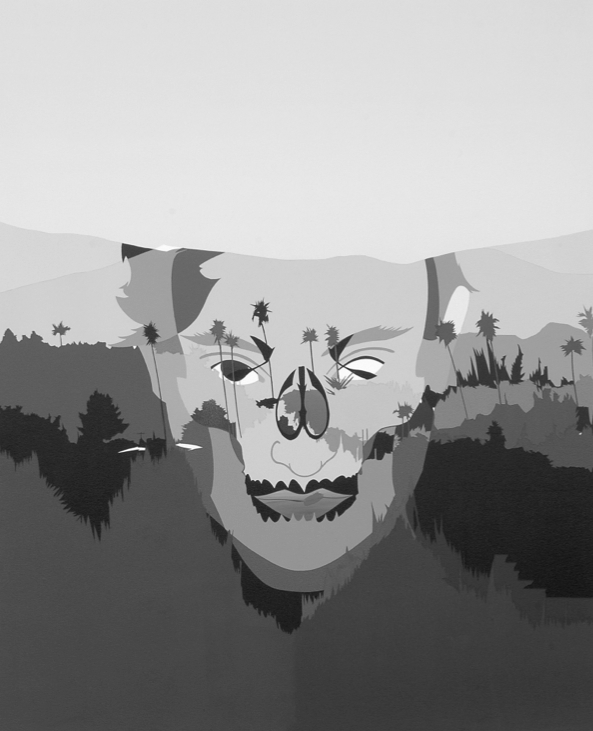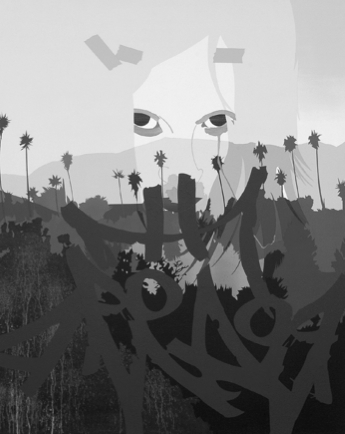Any resemblance between the characters herein and real persons living or otherwise is purely coincidental.
—Standard disclaimer
At heart, Marina Kappos is a storyteller. Even the gallery installation of her large-scale canvasses assumes a literary style of pacing. Conceived as one small segment in a greater series, every painting’s title is dispassionately reduced to its position in the sequence of creation. Kappos handles these nameless works like a disciplined writer, each treated as if it were a paragraph on an index card to be shuffled and reshuffled amongst the others until its position in the narrative flow is just right.
She set the scene of her most recent series, A Murder of Crows, in the low hills of an artificially verdant Los Angeles. In these works, crows reeled across a bright sky. As aggressive and conniving a species as our own, crows tag along with us wherever our territory expands. Here, the titular murder acted as familiars to guide viewers through the storyline.
Kappos habitually uses a stenciling technique to build thickened tissues of imagery onto her canvasses. In this particular series, however, the laminae of opaque acrylic became more than simple artifacts of process. In some instances, she painted over whole areas of her compositions, leaving the history of her elaborate mark-making masked but not entirely eliminated. Rendered thusly, her depiction of the actual landscape gave way to a quotation about place, or perhaps, even more remotely, about our disjointed memories of place. Her sublimated inscriptions also had the semblance of cicatrices, patterns of ritualized scars that literally demarcate an individual’s passage from one psychosocial state to another.
Seemingly devised to confound any such emotionally laden notion was the artist’s strategy of flattening many features of the Los Angeles landscape into matte silhouette. Because she kept perspectival tricks to a minimum, the familiar imagery of palm trees, stuccoed apartments, and smog-glazed hills began to verge on abstraction. In some works, muted color was drizzled onto the surface of the canvas to break up the impassivity of these broad shapes.
If Kappos were engaged in some postmodern critique (in which everything is reduced to undifferentiated surfaces by the flattening effects of late capitalism), then earlier, modernist motives also permeated her compositions as well. Representation yielded to the primacy of form and, quite pointedly, to the primacy of surface. Altogether it felt as if Kappos were quietly protesting to her viewers not to look any deeper into the works for meaning because “paint is just paint.”

Previously, Kappos created ambivalent and oftentimes outright unflattering portraiture of herself and the circle of family and friends surrounding her. Lucky for them, the cool and depthless execution of these paintings functioned to soften her blows. In some ways, her subjects always become ciphers in private plots of her own devising. In the latest pieces, her narratological focus was limited to herself and a lone friend, Terri. Here and there around the gallery, their disembodied faces materialized from within the landscape, manifesting with varying degrees of transparency.
In two such portraits (076 and 079, both 2004), aspects of the urban skyline as well as the women’s skulls appeared through their faces, giving both the countenance of mementi mori. These eerie visages also triggered recall of Claude Rains’ stop-action metamorphic return from the monstrous back to the human(e) at the moment of his character’s death in the 1933 horror classic, The Invisible Man. In this film, Dr. Jack Griffin allowed hubris to override better judgment when he injected himself with the dread substance “monocaine,” an exotic herbal extract that brought about invisibility. Although the drug was blamed, psychotherapists of the 1930s would have likely pointed to the total dissolution of the doctor’s ego as the true catalyst for his demise, for assuredly, Griffin disintegrated into madness nearly as rapidly as his flesh disappeared from sight. Once invisible, his actions were entirely governed by the id, as he became increasingly violent, insensitive to consequence, and finally self-destructive.

In The Ego and the Id, Sigmund Freud explored how the ego is shaped by perception of bodily sensations that spring primarily from the surface. He theorized the ego could thus be regarded as a “mental projection of the surface of the body.”1 Later, Didier Anzieu would return to Freud’s idea as he sought to extend Jacques Lacan’s conception of the Mirror Stage, an early developmental phase in which an infant forms an idea of the body, distinct from external reality. At this juncture, the child suppresses a fantasy of sharing a common surface with the mother. To differentiate from the outside world, the child must create a new mental image of the self, what Anzieu termed a “skin ego.” The ego builds like a “psychical callous,” using the body, and especially its surface, to select and sort the sensory information provided by perception.2 Indeed, the skin becomes a “…meeting place, not just of the senses, but of world and body.”3
The skin is both an organic and imagined reality.4 While its physical functions are perhaps better understood, the skin also acts as the ego’s proxy to the outside world, presenting certain aspects of subjecthood while veiling others—in a sense, putting our “best face forward.” Freud was on to the game. He called the ego a “frontier creature,” mediating between exterior reality and the untamed, pleasure-seeking demands of the id, by making the id “pliable to the world” and “the world fall in with the wishes of the id.”5 To achieve its objectives, the ego glosses over conflicts between the id and reality, becoming even “opportunistic and lying,” when need be, like a “politician who sees the truth but wants to keep his place in popular favor.”6 We dissemble to others and ourselves about what we are really like underneath it all (and on some level we know it). It should come as no surprise, then, that our suspicion of the surface is nearly innate. From early on, we are admonished never to accept things at “face value” because appearances can be deceptive. After all, beauty is only skin deep and, what is worse, the wolves around us hide in sheep’s clothing.

Any effacement of our outermost layer, the skin, could be interpreted as a bid to return to a more honest and immediate state. This return to nature, however, would be laden with far more than its typical bucolic implications. In effect, it reveals a yearning to regress into the undifferentiated and frequently chaotic phase that precedes the order and security imposed by the ego. To do so is clearly not without risk, a concept Kappos seemed to understand. Undoubtedly, the woman depicted in 086 (2005) paid the price for her desire, measured out in big dollops of sanity. If, however, 086 alluded to the madness that precipitates from the dissolution of self, then 082 (2005) suggested what a heady turn-on the end can be. In this painting, all that was left of the subject was a single eye, peering out from a hazy California sky, its expression wantonly “come hither.” A blink and it too would be gone.
Should we fear for Marina Kappos’ mind? The restrained painterliness with which her artworks were rendered implied she was fully in control of the line she drew between fact and fantasy. Moreover, there was nothing new or untoward about her introduction of imagery based on real people. Since the Renaissance, painters have inserted themselves, their bosses, and those near and dear into the frame of historic, allegoric, and ecclesiastic canvasses. Novelists, in the name of verisimilitude, are notorious for borrowing from life. A part of their game can be to see how close they can get to the truth without actually touching it (or allowing it to touch them). Indeed, the literary disclaimer has emerged as a device of expediency, brandished as frequently to rescue an author from being cornered at cocktail parties by boorishly inquisitive acquaintances, as it is to shield publishers from litigious accusations of slander. In viewing A Murder of Crows, we will never be allowed to know how close to the truth we got. But perhaps that is better, as it made the story told by Marina Kappos more intriguing.
Kristina Newhouse is curator of the Torrance Art Museum.
